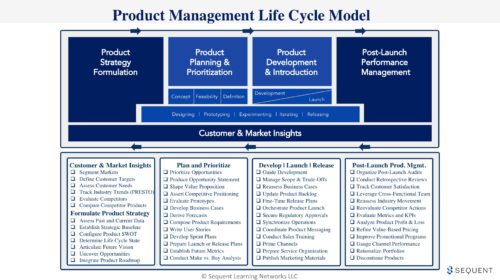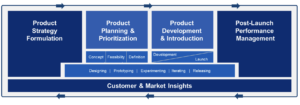Best-in-Class Product Management Framework: The Product Management Life Cycle Model


The first and second editions of The Product Manager’s Desk Reference have been a faithful companion to tens of thousands of product managers around the world. I’ve refreshed the book and introduced a 3rd edition that is updated, and better than ever. (Buy Now) In that new edition, I introduced an update to the Product Management Life Cycle Model. The Product Management Life Cycle Model has evolved over two decades and is based on a vast array of research done by my firm, Sequent Learning Networks where our benchmarks associate best practices with verified business outcomes.
The Product Management Life Cycle Model has achieved global recognition as a true representation of a product’s business from beginning-to-end. It provides a holistic view of what’s involved in the business management of a product.
Out of necessity, the model is a linear, progressive, and static depiction of something that is actually three-dimensional, recursive, and dynamic—but for most purposes, it’s a useful approximation. I say this because many people refer to a “product management process” as if it’s one set of things to do. It’s not. Instead, think of it as a meta-level grouping of processes and sub-processes, as represented by broad areas of work. These include:
- Customer and Market Insights
- Product Strategy Formulation
- Product Planning & Prioritization
- Product Development & Introduction
- Post-Launch Performance Management
Here’s a way to think about the issue of a linear vs. dynamic perspective you’ll need to adopt. Let’s say you’ve assessed your customers and feel certain that the needs you uncovered are valid, and then you shape your strategy around them. From this, you might begin working on some user stories or requirements, and perhaps even create a rough prototype or drawing. Taking it further, if you share your work with a customer to secure their opinion, or uncover that a competitor is already doing similar work, would you make a different decision about what to invest, or even how to adjust your strategy?
If you rigidly adhere to your strategy with new information, your product will likely hit a dead-end. Therefore, you might just need to tweak your strategy and consider other options. Hence, you’re going back and forth; almost like you’re editing a book.
The Product Management Life Cycle Model represents a way to think about all the moving parts of your products business and reveals the overarching instrumentation you need to assess customers and markets, formulate strategies, shape your product investments, develop, and release your products, and manage them once they’re in the market.
It’s not about product development. It’s not about agile. It’s not about waterfall. It’s just business.
Watch and listen to the video. If it makes sense, give me a call about how I can help your company or your team.
